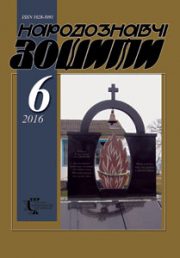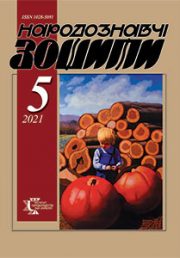The Ethnology Notebooks, 2018, № 5 (143), 1320—1325
UDK 792.051:662.11
DOI https://doi.org/10.15407/nz2018.05.1320
Received 15.08.2018
FIERY EFFECTS AS AN ELEMENT OF VISUAL DESIGN OF PUBLIC SPACE
ORCID ID: https://orcid.org/0000-0003-2665-390X
Yudova-Romanova Kateryna, Candidate of Art Studies, Ph.D, research fellow
in the Department Associate Professor, the department of theatrics KNUKiM
Ye. Konovaltsia Street 36, 01601, Kyiv, Ukraine.
Contacts: e-mail: iudovakateryna@gmail.com; tel. 050-381-22-92, 044-528-34-97
Abstrakt. The interdependence of the contents and forms in the art of visual design of the stage space by fire and pyrotechnics has been analyzed; locations for public events using pyrotechnics were described. Ritual fire is recognized to be an integral part of the protodesign of religious structures of ancient Slavs. In Kupala rites, fire was used both as a game requisite and as a designing tool for a public space in which a ritual act was taking place. The flame of the Kupala bonfire can be interpreted as a static objectfire design tool for public space; candles in the Kupala tree, in wreathsbaskets on the water, fire wheels — as moving floral and fiery design tools. Modern pyrotechnic sights contribute to the popularization of public space. Its architecturalspatial characteristics influence the choice of directors about design option of stageviewers’ space and the filling of the pyrotechnic scenario with the relevant elements.
Keywords: fiery effects, pyrotechnics, public space, pyrotechnic art.
REFERENCES
Aronov, L.M. (1998). The experience of staging amass theatrical performance on the material of classical drama. Moscow: MGIK [in Russian].
Aseev, B.N. (1977). Russian Drama Theater from the beginnings to the middle of the 18th century. Moscow: Iskusstvo [in Russian].
Bazanov, V.V. (1973). The main problems of using technology in the modern play. Stage technique and technology, 2, 15—18 [in Russian].
Bakhtin, M.M. (2010). Creativity Francois Rabelais and the folk culture of the Middle Ages and the Renaissance. In Collected Works. (Vol. 4). Moscow: Russkie slovari [in Russian].
Berezkin, V.I. (2011). From the Beginning to the Mid-20th Century. In The Art of Scenography of the World Theater (Vol. 1). Moscow: URSS [in Russian].
Boyadzhiev, G.N. (1956). Theater of the era of the rise and flowering of feudalism. In History of the West European Theater (Vol. 1). Moscow: Iskusstvo [in Russian].
Brabich, V., & Pletneva, G. (1971). Spectacles of the Ancient World. Leningrad: Iskusstvo [in Russian].
Brudnyj, V.I. (1968). Rites yesterday and today. Moscow: Nauka [in Russian].
Buller, M.F. (2009). Industrial Explosives. Sumy: SumGU [in Russian].
Vejtser, Yu.I., & Luchinskij, G.P. (1947). Masking Smokes. Moscow, Leningrad: GNTIHL [in Russian].
Demidov, А.I. (1939). Introduction to pyrotechnics (pyrotechnic compositions). Moscow: Gosudarstvennoe voennoe izdatel’stvo narkomata soyuza SSSR [in Russian].
Dubin, B.V. (2013). Theatricality within the boundaries of art and beyond. In Simvoly — instituty — issledovaniya: Novye ocherki sotsiologii literatury (pp. 123—134). Saarbrücken: Lap Lambert Academic Publishing [in Russian].
Ivanova, Yu.I. (1983). Ritual Fire. In Calendar custom sinthe countries of foreign Europe: Historical roots and development of customs (pp. 116—130). Moscow: Nauka [in Russian].
Ivanova, Yu.I. (1983). Traces of the solar cult. In Calendar customs in the countries of foreign Europe: Historical roots and development of customs (pp. 105—116). Moscow: Nauka [in Russian].
Golovnya, V.V., Boyadzhiev, G.N., & Bartoshevich, А.V. (1971). The Theater of Western Europe. In History of foreign theater (Vol. 1). Moscow: Prosveshhenie [in Russian].
Makarov, А. (2005). Amusing lights. In Small encyclopedia of Kiev antiquity (pp. 374—375). Kyiv: Dovіra [in Russian].
Platov, G.А. (2005). Pyrotechnics. The art of making fireworks. Moscow: Jeksmo [in Russian].
Plachynda, S.P. (1993). Dictionary of ancient Ukrainian mythology. Kyiv: Ukrains’kyj pys’mennyk [in Ukrainian].
Giesen, B. (2006). Performance art. In Social Performance. Symbolic Action, Cultural Pragmatics and Ritual (pp. 315—325). Cambridge: Cambridge University Press.
Lehmann, H.-T. (2006). Post dramatic Theatre. NewYork: Rout ledge.
Kalmanovskij, E. (1993). The nature of theater and the idea of theatricality. Peterburgskij teatral’nyj zhurnal, 3. Retrieved from: http://ptj.spb.ru/archive/1/in-empyrean-1/priroda-teatra-iideya-teatralnosti/ (Last accessed: 08.09.2018).







